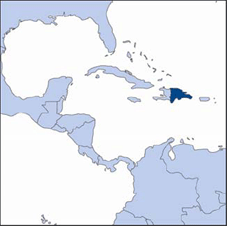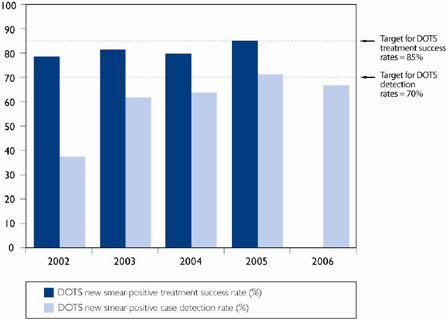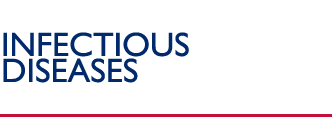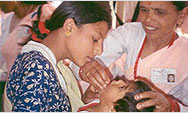Dominican Republic

|
| |
According to the World Health Organization’s (WHO’s) Global TB Report 2008, the
Dominican Republic had an estimated 8,534 tuberculosis (TB) cases in 2006, with an
estimated incidence rate of 89 cases per 100,000 population. Between 2002 and 2006,
the case detection rate for sputum smear-positive (SS+) cases increased from 38 to 66
per 100,000 population, approaching the WHO global target of 70 percent. The
National TB Control Program (NTCP) began implementing DOTS (directly observed
treatment, short course) in 1998, and has recently made progress in expanding it
throughout the country. By the end of 2004, DOTS services reached 80 percent of the
population compared with 40 percent in 2002, and DOTS coverage is available at more
than 900 service points. The Dominican Republic has one of the highest rates of TB
drug resistance in the Western Hemisphere and multidrug-resistant (MDR)-TB has
remained a persistent challenge to TB control over time. The prevalence of MDR-TB
may have fallen according to preliminary results of a recent drug resistance survey. A
survey conducted in 1995 reported a prevalence of 8.2 percent while a survey in 2008
reported 6.3 percent. However, further analysis will be performed in the near future
to determine whether these are new or previously treated cases.
The Dominican Republic also has a serious HIV/AIDS problem, with an adult HIV
seroprevalence rate of 1.1 percent. In 2006, an estimated 3.3 percent of new TB
patients had HIV/AIDS. As access to counseling and testing services for HIV/AIDS
increases and better data become available, the detection rate of TB-HIV/AIDS coinfection
will likely increase.
USAID Approach and Key Activities
USAID assistance to the Dominican Republic’s NTCP began in 2001. Since then,
USAID funds for TB programming in the Dominican Republic averaged $1.3 million per
year. In coordination with the Pan American Health Organization (PAHO) and the
NTCP, USAID is supporting DOTS programs in seven provinces and expanding
services to five more provinces. USAID’s program focuses on strengthening DOTS
through decentralization and better integration into primary health care services and by
improving the diagnosis and treatment for MDR-TB, increasing coordination of TBHIV/
AIDS activities, and expanding private sector involvement in TB control. USAID
assistance includes support for the following activities:
- Increasing political commitment for DOTS implementation using evidencebased
approaches
- Increasing public and private sector participation in DOTS implementation
- Increasing and strengthening TB and HIV/AIDS coordinated and collaborative
activities
- Performing external evaluations of the NTCP
- Training health personnel, including doctors, nurses, laboratory
technicians, and health promoters, in the DOTS approach
- Developing community education and social mobilization strategies
- Expanding MDR-TB services to reduce the number of patients not yet on
treatment
- Further integrating DOTS into primary care
USAID Program Achievements
USAID’s assistance has contributed to improvement in human resources and infrastructure through the following activities:
- Reached the WHO target of 85 percent for treatment success rate for the 2005 cohort
- Implemented a pharmaceutical procurement and logistics system that resulted in saving the NTCP an estimated $800,000
per year
- Supported the annual external and internal evaluations of all the TB program components of the NTCP and provided the
Ministry of Health with recommendations for program improvement
- Supported treatment for MDR-TB in two public hospitals in coordination with the Global Fund to Fight AIDS,
Tuberculosis and Malaria
- Strengthened quality control and laboratory services in order to process cultures for a TB network of eight regional labs
and approximately 164 provincial and local laboratories
- Developed a national manual for recording and reporting systems that has innovative components on identification of
suspected TB cases, TB-HIV/AIDS collaboration, and contact tracing
- Established drug resistance surveillance systems
- Conducted courses on quality control for 72 laboratory specialists, enabling the introduction of quality control into the
laboratory network
- Supported nine nongovernmental organizations to provide social mobilization support for the NTCP in 145 communities
and 80 towns and trained more than 220 health providers, 233 community organizations, and 1,443 community
volunteers on TB control
- Participated in a strong collaborative effort among partners, resulting in a coordinated program implementation
Case Detection and Treatment Success Rates Under DOTS
 |
Note: DOTS treatment success rate for 2006 will be reported in the 2009 global report.
Source: Global Tuberculosis Control: Surveillance, planning, financing:WHO Report 2008 |
Partnerships
USAID partners in TB control in the Dominican Republic include the NTCP, the PAHO, the Tuberculosis Coalition for Technical Assistance, the Royal Netherlands Tuberculosis Association, PROFAMILIA, and Management Sciences for Health’s Rational Pharmaceutical Management Plus Program. The Global Fund approved $4.6 million in Round 3 funding and $10.3 million in Round 7 funding for TB control in the Dominican Republic.
1 Survey results reported by USAID/Dominican Republic
January 2009
Related Links
|


